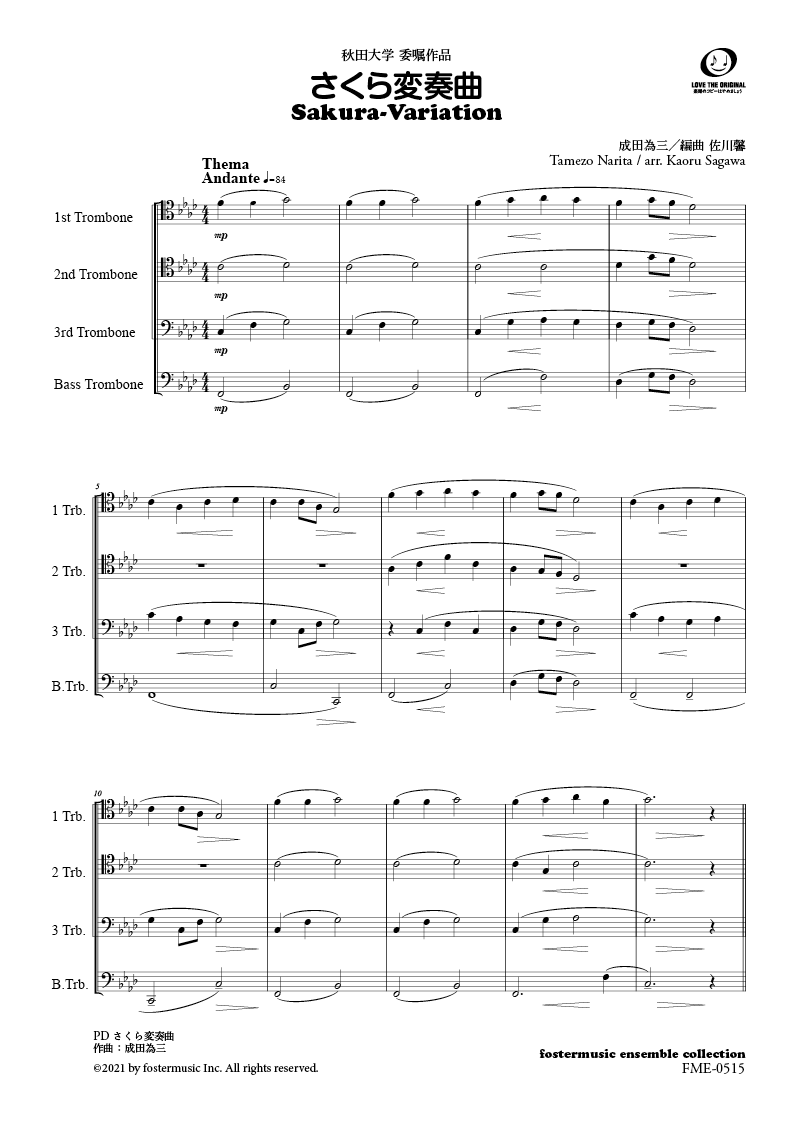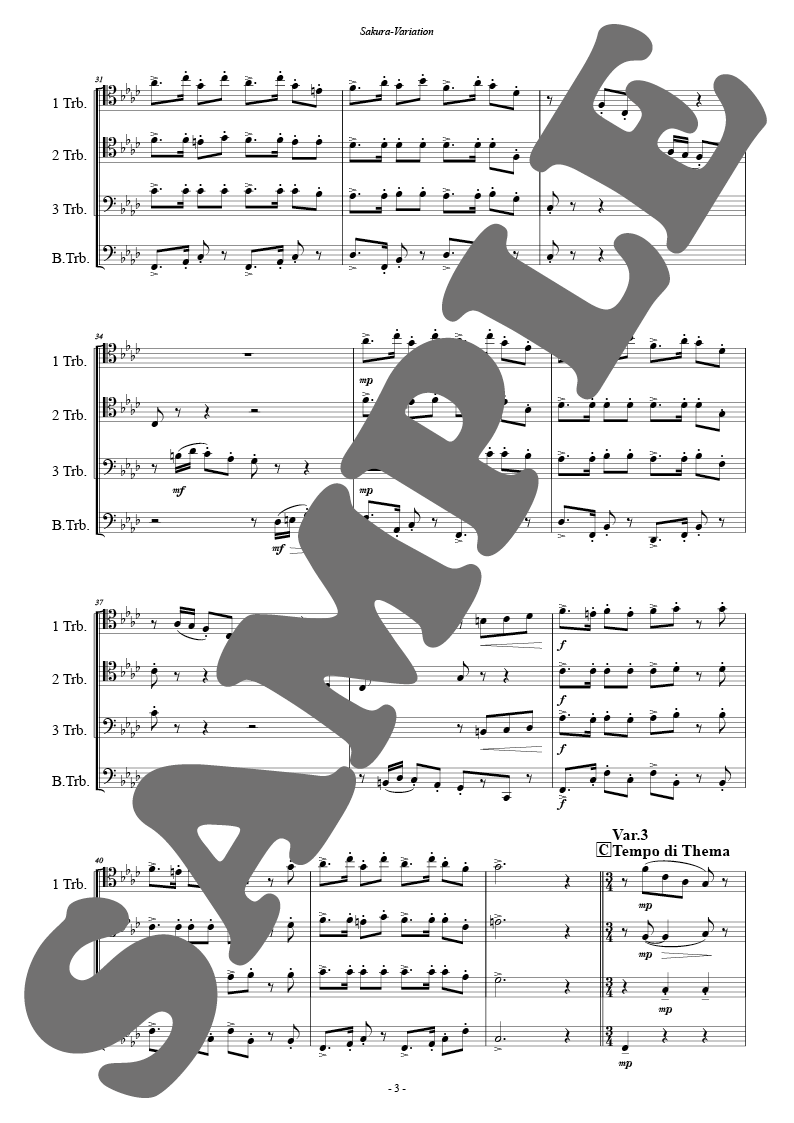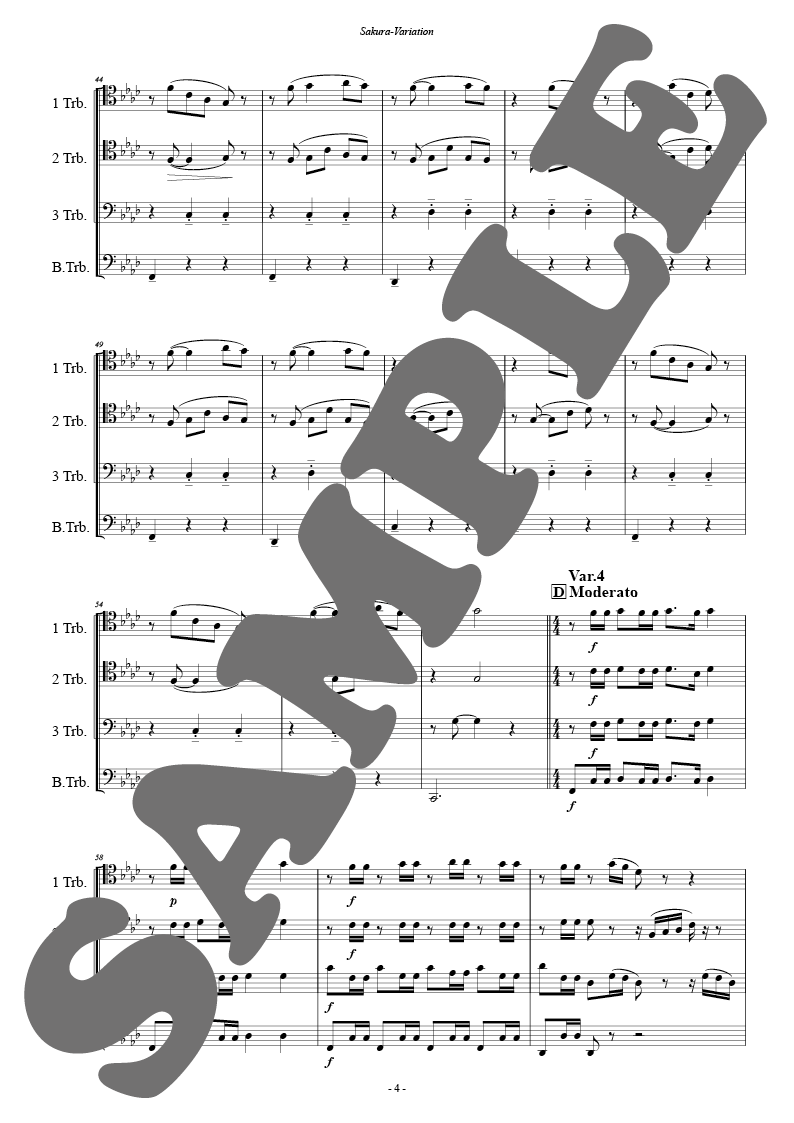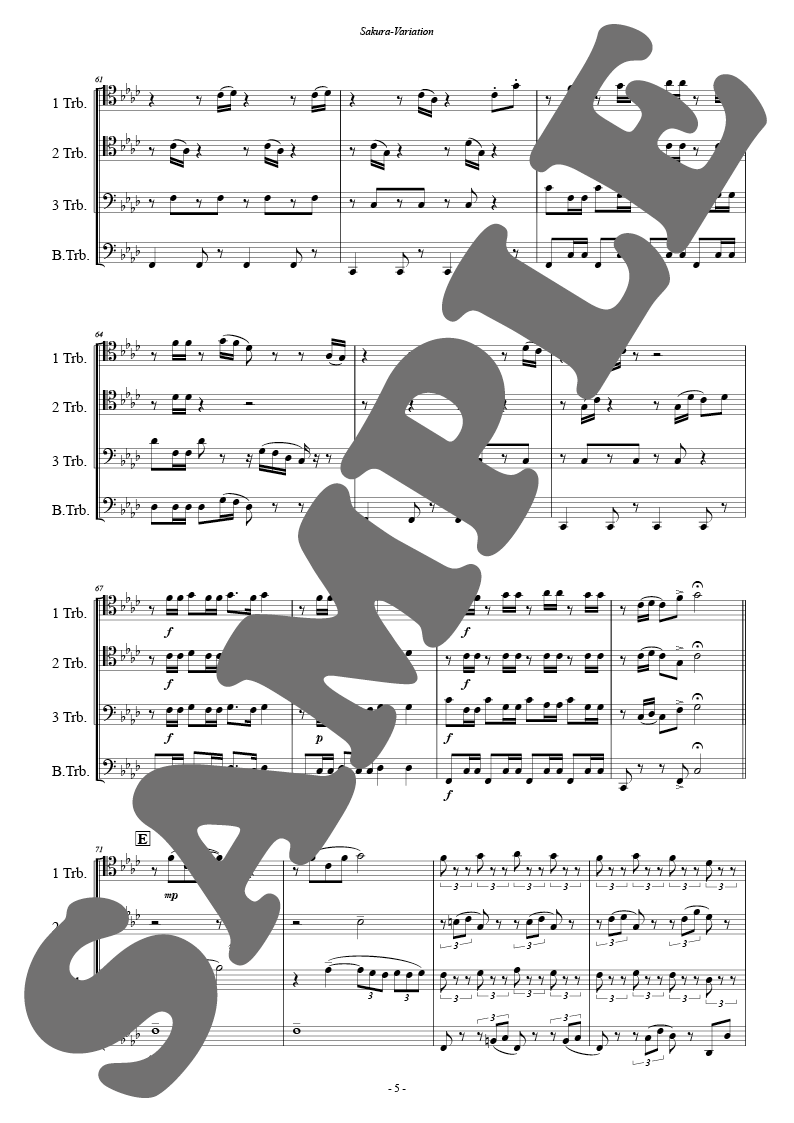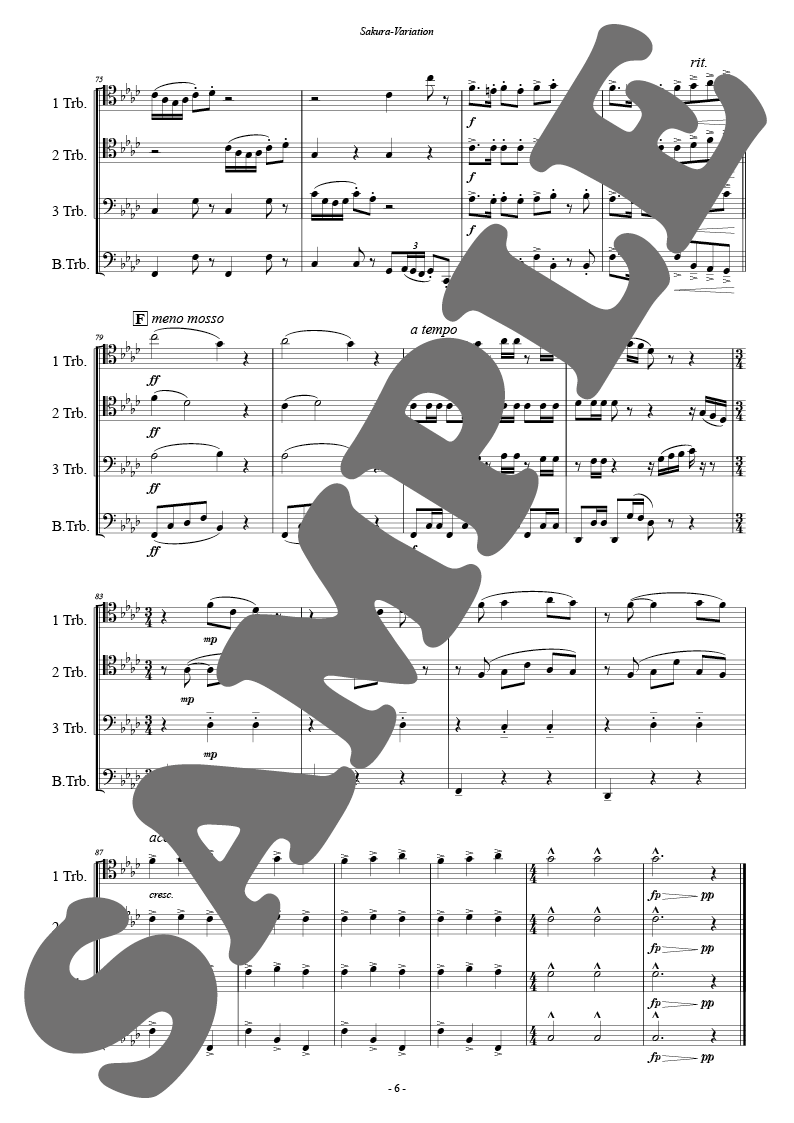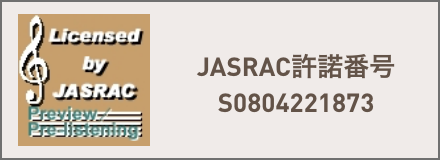12月25日15時を持ちまして、
2025年内出荷の注文受付を終了いたしました。
以降のご注文は年明け
【 2026年1月7日(水)以降順次出荷 】
となります。予めご了承ください。
本年もたくさんのご愛顧を賜りありがとうございました。
よいお年をお迎えください。
さくら変奏曲:成田為三 arr. 佐川馨 [トロンボーン4重奏]
・1配送につき税込11,000円以上のご注文で国内送料無料
・コンビニ後払い、クレジットカード、銀行振込利用可
・[在庫あり]は営業日正午までのご注文で即日出荷
・International Shipping
- 概要
- 編成/曲目
- 補足
- ENGLISH
さくら変奏曲
中学校の教科書教材「浜辺の歌」や童謡「かなりや」で知られる成田為三(1893-1945)は秋田県米内沢出身の作曲家である。地元の小学校から准教員準備場に進み、秋田県師範学校を経て小学校の教員となった。しかし師範学校で出会った西洋音楽に魅せられ、1年間の教員生活の後に、次の学校への転任の辞令が出ていたにも関わらず、上京して東京音楽学校の甲種師範科に入学したという逸話をもつ。
作曲は東京音楽学校に在学中に、ドイツ留学から帰国して間もない山田耕筰に師事した。同門には指揮者の近衛秀麿、「椰子の実」で知られる大中寅二らがいる。大正10(1921)年、27歳の時にドイツに留学し、音楽界の重鎮ロベルト・カーンの下で4年間に亘って作曲を学んだ。「浜辺の歌」が有名過ぎるために唱歌や童謡の作曲家と思われがちであるが、ピアノ曲からオーケストラまで幅広く作曲し、当時の作曲家の中でも最新の音楽理論に裏付けされた高い実力を持った一人であった。300曲余りの作品があるとされているが、残念ながら大半が第二次大戦の空襲で焼失している。
「さくら変奏曲」はピアノのための独奏曲である。14小節の日本古謡「さくらさくら」のテーマに続いて9つの変奏がなされ、箏の手事を連想させるようなcodaで締めくくる。作曲年代は未詳であるが、同種の作品に昭和18(1943)年出版の「君が代変奏曲」、昭和17(1942)年出版の「浜辺の歌変奏曲」があるので、その近辺であると予想される。この編曲では、トロンボーンの演奏に適する箇所を抜粋して再構成した。(佐川馨)
仕様
- 演奏形態
- トロンボーン
- 編成
- 4重奏
- 演奏時間
- 0:04:00
- グレード
- 4
- 商品形態
- アンサンブル楽譜(Full Score & Part)
- 出版社 / 品番
- フォスターミュージック / FME-0515
- JANコード
- 4560318477452
- 発売日(年)
- 2021/12/02
- キーワード
- 桜, 春, 童謡, ,
楽器編成
- Full Score
- Trombone 1
- Trombone 2
- Trombone 3
- Bass Trombone
- サイズ
- A4/1cm未満
SAKURA-VARIATION
Renowned for "Song of the Seashore", popularly used as a middle school teaching resource, as well as children's song "Canary", Tamezo Narita (1893~1945) was a composer from the town of Yonaizawa, Akita Prefecture. From the associate teacher preparation center of his hometown's elementary school, he went on to graduate from Akita Normal School to become an elementary school teacher. However, captivated by the Western music he heard during his tenure at the normal school, after a year of teaching, he disregarded the notice of transfer, instead moving to Tokyo to attend Tokyo Music School's first class normal school course.
His composing journey during his time at Tokyo Music School was overlooked by Kosaku Yamada, who had just returned from an exchange to Germany. Fellow students included conductor Hidemaro Konoe, as well as Toraji Onaka, who was known for his choral arrangement of "Coconuts". In 1921, at the age of 27, Narita would go on exchange to Germany for four years, studying composition under the wing of Robert Kahn, a musical luminary of the time. Due to the immense popularity of Narita's "Song of the Seashore", he is often seen as a composer of choral works and children's songs, but in reality he composed for a wide range of instrumentation ranging from piano solo to orchestra, and expressed a keen interest and ability in the newest developments in music theory, even among composers of his era. He is believed to have composed over 300 works, but unfortunately a large majority of these were destroyed by aerial bombing during World War Two.
"SakuraVariation" is a piece for solo piano. Following the 14bar theme of the traditional Japanese folk song "Sakura Sakura", there are nine variations, after which the coda, reminiscent of the sound of a koto, concludes the piece. The year of composition is unknown, but similar works like his 1943 "Variations on the Theme of Kimigayo" and his 1942 "Song of the Seashore Variations" lead many to believe it was composed around the time. This arrangement is a reorganized selection of passages to better suit the trombone instrumentation.
Specifications
- ARTIST
- Composer: Tamezo NARITAArranger: Kaoru SAGAWA
- INSTRUMENTATION
- Trombone / Quartet (4parts)
- DURATION
- 0:04:00
- GRADE
- 4
- PRODUCT TYPE
- Set / ENSEMBLE (Full Score & Part)
- PUBLISHER / Code
- fostermusic Inc. / FME-0515
- JAN
- 4560318477452
- RELEASE
- 2021/12/02
- OVERSEAS SHIPMENT
- EUROPEAN PARTS
- Not Included

![さくら変奏曲:成田為三 arr. 佐川馨 [トロンボーン4重奏]](/html/upload/save_image/FME0515_1.png)
